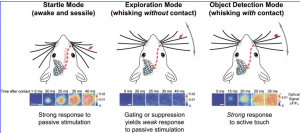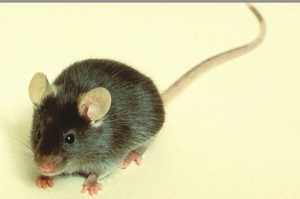As with any pest knowledge is the key to complete control and this can be very helpful with mice. Generally speaking mice are very athletic, have excellent sense of smell, hearing and touch. The reaction time of a house mouse can frustrate even the best of trappers as they quite often escape a snap traps jaws that close shut in less than 1/38 thousands of a second. Many a home owner have laid out multiple traps, glue boards and rodent baits only to be discouraged by the ongoing struggle with the mouse. Knowing this creatures weakness will improve your chances a great deal in ridding your home of this persistent escape artist. I’ll give you a clue, it’s all in the whiskers.
#1 Mice have poor vision. The reason this is important to you is so you can set your trapping devices in places you know you’ll have the best chance of getting your mouse. Being that the mouse does not see well it tends to run along side of walls or objects and uses its whiskers in a manner much like a blind man might use a cane. The vibrissae (whiskers) are very sensitive and tell a mouse much more than it’s next to a wall. Combined with their sense of smell the mouse will approach certain objects differently based on the information they feel. The vibrissae are connected to the brain of the mouse and have 3 distinct modes. Startle mode which triggers motion, exploration mode which they actually whisk their vibrissae in the air as detectors and object detection where they feel an object using this highly sophisticated sense. What we think of as just cute whiskers are actually very important to a mouse and if you were to cut them off you would get the same result as if taking away the cane from a sight impaired person or the antenna off a roach.
exploration mode which they actually whisk their vibrissae in the air as detectors and object detection where they feel an object using this highly sophisticated sense. What we think of as just cute whiskers are actually very important to a mouse and if you were to cut them off you would get the same result as if taking away the cane from a sight impaired person or the antenna off a roach.
#2 Mice are creatures of habit. Mice do explore their entire territory every night when they come out looking for food and they readily investigate new items. However they rarely wander out of their territory (15 to 30 feet) because they lose the sense of comfort in this yet unexplored area. Mice use the same pathways over and over and although they may zig zag back and forth, the home area of the mouse is very familiar to them and in an instant they can disappear under the stove or refrigerator because they know exactly where they are at all times.
 Using their achilles heel against them. While a mouses vibrissae make up for a lot of their poor vision it can’t fully replace the value of sight. Combine that with their curiosity and need for familiar surroundings and you have a great recipe for catching this illusive pest. The strategy is simple, place ALL of your traps against walls, objects or in known runways and never in the middle of the floor or out in the open. Change up their surroundings by rearranging the room or counter top and force them to to be less sure of where they are going or how they’ll get there. Create runways for them using boxes or objects that direct them directly into your trap and change some trap placements if the first night or two is not successful. While this approach would rarely work for a rat it can dramatically improve your efforts for the common house mouse and his achilles heel. If this all seems too much it may be time to just let the experts handle it .
Using their achilles heel against them. While a mouses vibrissae make up for a lot of their poor vision it can’t fully replace the value of sight. Combine that with their curiosity and need for familiar surroundings and you have a great recipe for catching this illusive pest. The strategy is simple, place ALL of your traps against walls, objects or in known runways and never in the middle of the floor or out in the open. Change up their surroundings by rearranging the room or counter top and force them to to be less sure of where they are going or how they’ll get there. Create runways for them using boxes or objects that direct them directly into your trap and change some trap placements if the first night or two is not successful. While this approach would rarely work for a rat it can dramatically improve your efforts for the common house mouse and his achilles heel. If this all seems too much it may be time to just let the experts handle it .
For more information please watch my video on Trapping rats and mice.




